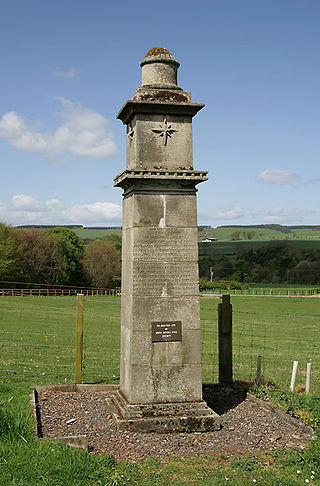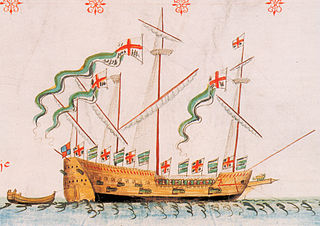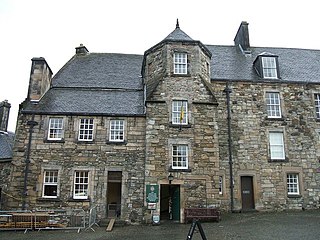
James IV was King of Scotland from 11 June 1488 until his death at the Battle of Flodden in 1513. He inherited the throne at the age of fifteen on the death of his father, James III, at the Battle of Sauchieburn, following a rebellion in which the younger James was the figurehead of the rebels. James IV is generally regarded as the most successful of the Stewart monarchs. He was responsible for a major expansion of the Scottish royal navy, which included the founding of two royal dockyards and the acquisition or construction of 38 ships, including the Michael, the largest warship of its time.
Sir Andrew Barton was a Scottish sailor from Leith. He gained notoriety as a privateer, making raids against Portuguese ships. He was killed in battle and memorialised in English and Scottish folk songs.

The Royal Scots Navy was the navy of the Kingdom of Scotland from its origins in the Middle Ages until its merger with the Kingdom of England's Royal Navy per the Acts of Union 1707. There are mentions in Medieval records of fleets commanded by Scottish kings in the twelfth and thirteenth centuries. King Robert I developed naval power to counter the English in the Wars of Independence (1296–1328). The build up of naval capacity continued after the establishment of Scottish independence. In the late fourteenth century, naval warfare with England was conducted largely by hired Scots, Flemish and French merchantmen and privateers. King James I took a greater interest in naval power, establishing a shipbuilding yard at Leith and probably creating the office of Lord High Admiral.

Dunbar Castle was one of the strongest fortresses in Scotland, situated in a prominent position overlooking the harbour of the town of Dunbar, in East Lothian. Several fortifications were built successively on the site, near the English-Scottish border. The last was slighted in 1567; it is a ruin today.

Gavin Dunbar was a 16th-century bishop of Aberdeen. He was the son of Sir Alexander Dunbar of Westfield, near Elgin and Elizabeth Sutherland, apparently a daughter of Alexander Sutherland, Laird of Duffus. Gavin Dunbar, Archbishop of Glasgow, was his nephew.
Margaret was a Scottish warship of the 16th century.

Darnaway Castle, also known as Tarnaway Castle, is located in Darnaway Forest, 3 miles (4.8 km) southwest of Forres in Moray, Scotland. This was Comyn land, given to Thomas Randolph along with the Earldom of Moray by King Robert I. The castle has remained the seat of the Earls of Moray ever since. Rebuilt in 1810, it retains the old banqueting hall, capable of accommodating 1,000 men.

The Scottish royal tapestry collection was a group of tapestry hangings assembled to decorate the palaces of sixteenth-century kings and queens of Scotland. None appear to have survived.

Antoine d'Arcy, sieur de la Bastie-sur-Meylan and of Lissieu, was a French nobleman involved in the government of Scotland.
Lion was the name of five warships of the Royal Scottish Navy during the 16th century, some of which were prizes captured by, and from the English. The names of these ships reflect the Royal Arms of Scotland and its central motif of the Lion Rampant.

Salamander was a warship of the 16th-century Royal Scots Navy. She was a wedding present from Francis I of France to James V of Scotland.
Robert Barton of Over Barnton was a Scottish landowner, merchant, sailor and politician. He served as Comptroller, Master of the Mint and Lord High Treasurer to James V of Scotland.
John Drummond of Milnab was a 16th-century Scottish carpenter in charge of the woodwork of the palaces, castles and guns of James IV of Scotland and James V of Scotland.
John Damian de Falcuis was an Italian at the court of James IV of Scotland. His attempts at medicine, alchemy, flying, and his advancement by the king encouraged a satirical attack by the poet William Dunbar.

John Chisholm was a 16th-century Scottish soldier and the chief officer, Comptroller and Prefect of the Scottish artillery for Mary, Queen of Scots and James VI of Scotland. He was also keeper of the King's Wark in Leith. Chisholm was a supporter of Mary, Queen of Scots in the years after her exile in England.

Ellen or Elen More was an African servant at the Scottish royal court. She probably arrived in Scotland in the company of a Portuguese man with imported animals. There are records of clothing and gifts given to her, although her roles and status are unclear. Some recent scholarship suggests she was enslaved, and her arrival in Scotland can be linked indirectly with the slave trade. She is associated with a racist poem by William Dunbar, and may have performed in Edinburgh as the "Black Lady" at royal tournaments in 1507 and 1508.

Andrew Aytoun, was a Scottish soldier and engineer, and captain of Stirling Castle.

Walter Merlioun, was a Scottish master mason based in Edinburgh.
William Foular was a Scottish apothecary who served the Scottish court.

The More Taubronar was a musician of African origin at the court of James IV of Scotland and his wife Margaret Tudor. His name is unknown. A "taubron" was a kind of drum, the word is related to the modern form "tabor". The word "More" or "Moryen" was used for people of African origin at the Scottish court. Archival records credit the More Taubronar as the producer of a costumed dance or masque performed at the Scottish royal court in 1505.












